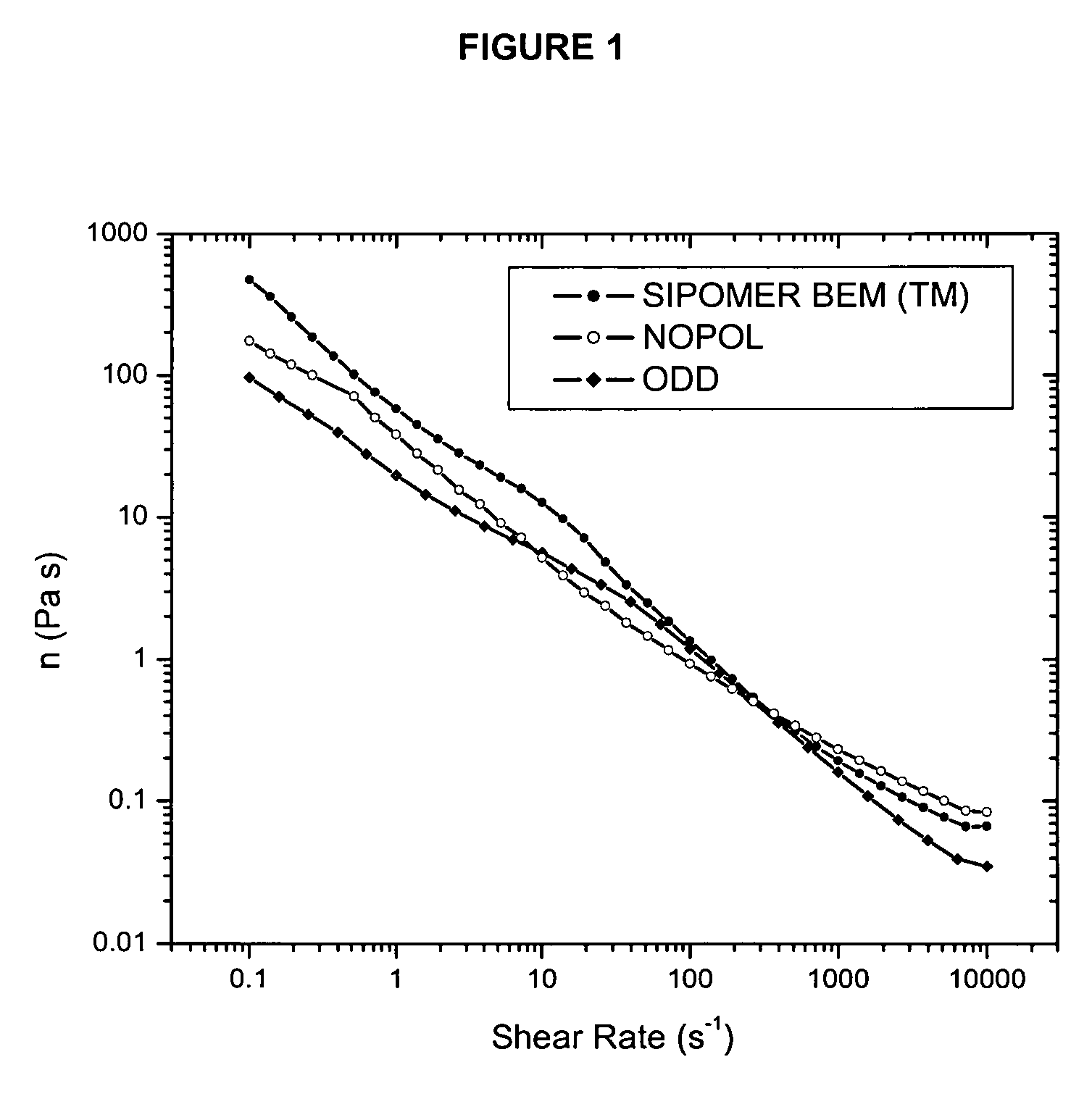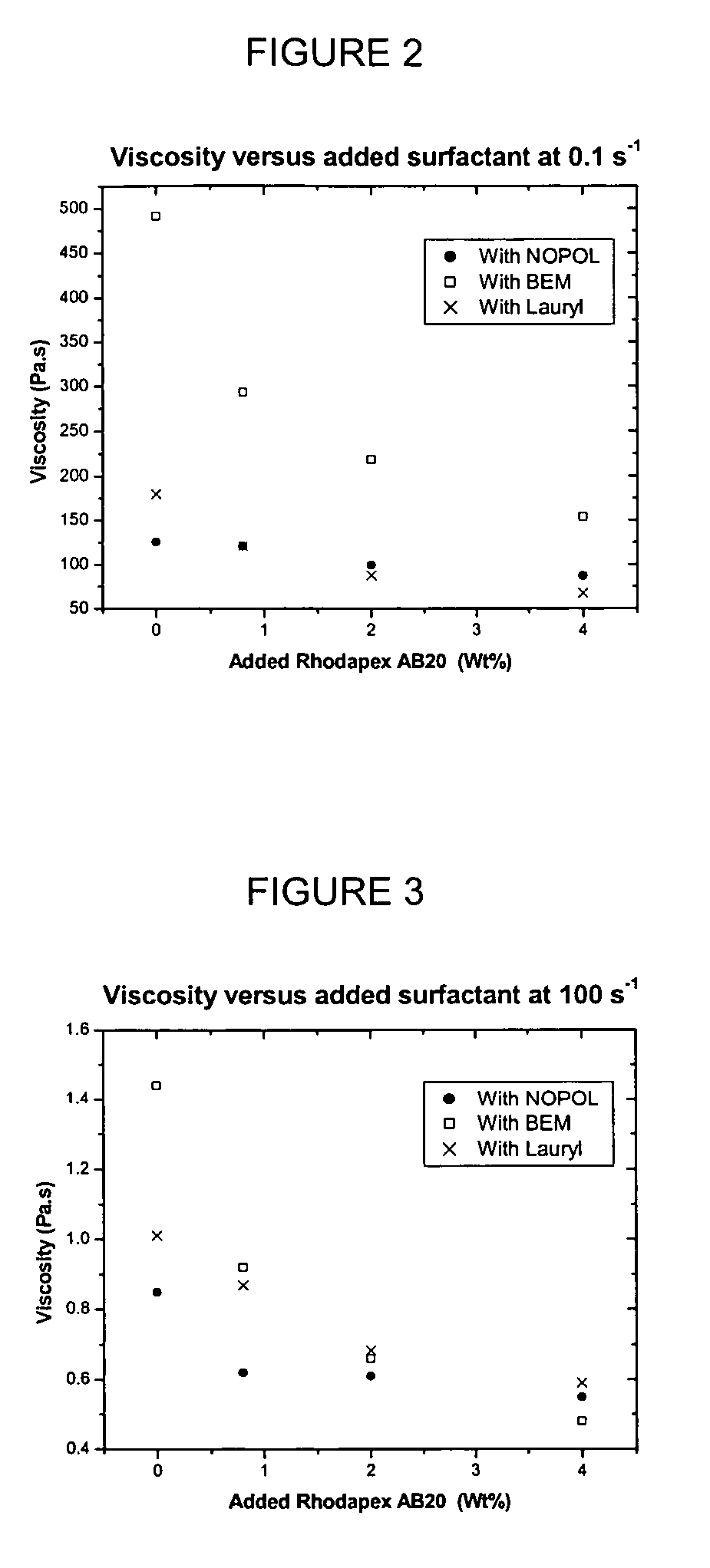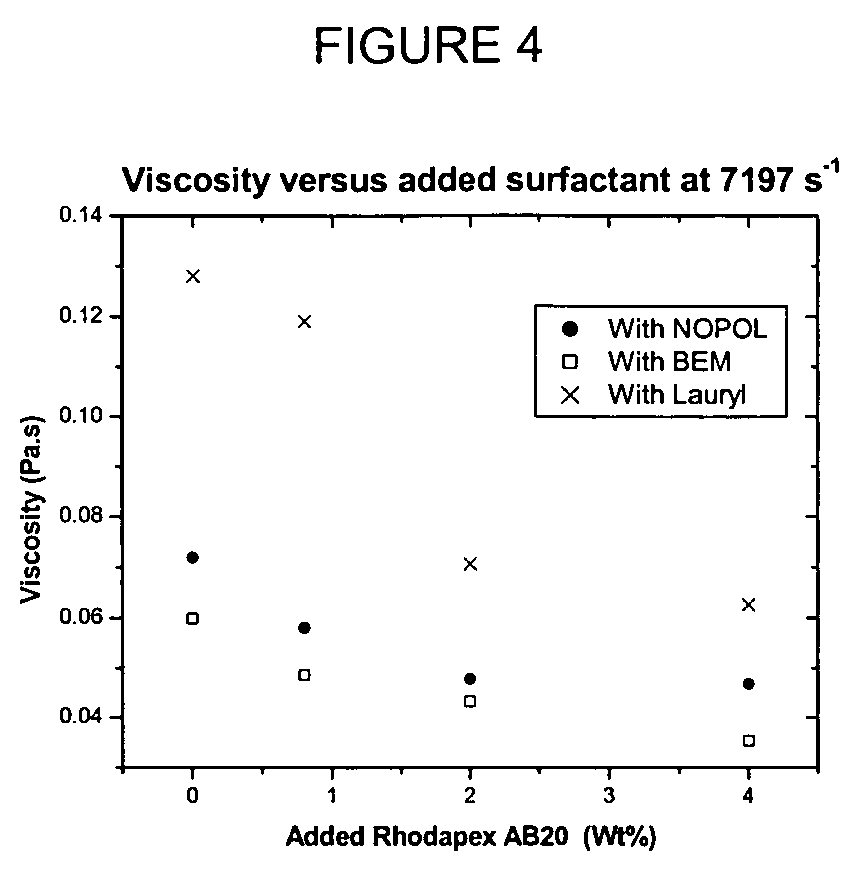Compositions having HASE rheology modifiers
a technology of modifiers and compositions, applied in the field of compositions having rheological modifiers, can solve the problems of affecting the permeability of compositions, so as to improve the permeability and flow control, and improve the permeability and dispersion. the effect of reducing the number of lumps
- Summary
- Abstract
- Description
- Claims
- Application Information
AI Technical Summary
Benefits of technology
Problems solved by technology
Method used
Image
Examples
example i
Monomer Synthesis
[0176]The monomer of Example 1A, according to structure (XXI), which is referred to as “ODD”:
[0177]
is made as follows. 2-Octyl-1-dodecanol ethoxylate (25 moles of ethylene oxide per mole, 214g =0.15 mol) is charged to a 500ml round-bottom 5-neck glass flask equipped with a PTFE blade agitator, temperature sensor, dry compressed air purge line and a water cooled condenser. The liquid ethoxylate is warmed to 69° C., stirred, and MEHQ (0.35g =0.0027 mol) is then added. A purge of dry air at approximately 20 ml min−1 is passed through the liquid and five minutes later methacrylic anhydride (46.7g=0.303 mol) is added. The temperature is stabilized and held between 70-73° C. for five hours, then the liquid is cooled to 40° C. Methacrylic acid (35.0 g=0.407 mol) and water (67.0 g=3.72 mol) are added and the liquid product is discharged.
[0178]The monomer of Example 1 B according to structure (XXII), which is referred to as “NOPOL”:
[0179]
is made as follows Nopol alkoxylate (...
example 2
Preparation of HASE Systems
[0180]The HASE polymers of Examples 2A and 2B and the HASE polymer of Comparative Example C2 are each made according to the procedure set forth below.
[0181]Add heat to kettle charge to about 80° C. while purging with N2. Maintain N2 blanket throughout run. At about 80° C., add 25% Initiator solution and 2% Monomer emulsion. Hold at that temperature for about 15 minutes. Feed remainder of monomer emulsion and initiator solution over 3 hours. Hold for 30 minutes, and add the chaser solution. Finally, heat to about 80° C. and hold for 30 minutes, and allow to cool. The ingredients used are shown in TABLE I below.
[0182]
TABLE IIngredientMaterialsweight (g)% BOTM*Kettle ChargeDeionized Water120.00 Rhodapex AB20 @ 29.0% 0.410.12Ammonium persulfate 0.180.18Monomer EmulsionDeionized Water67.83Rhodapex AB20 @ 29.0% 6.902Methyl acrylic acid (MAA)40.0040Ethyl acrylate (EA)56.0056Component C 60.1% 6.664Initiator SolutionDeionized Water40.00Ammonium Persulfate 0.250.25C...
example 3
Latex Coatings
[0186]The HASE polymers of Examples 3A, 3B and C3-1 (each analogous to a respective one of the polymers described in Examples 2A, 2B, and C2 above), were each then mixed with a paint latex (VALSPAR 153-16 by Valspar Corp.) in the necessary quantities to reach a Stormer viscosity of 95 KU (Krebbs Units). The mixtures were tested for viscosity versus shear rate
[0187]The viscosity (in units of Pascal seconds (“Pa s”) at very low shear rate (film formation) are given in TABLE II below.
[0188]
TABLE IIAnalogous topolymer ofComponent CViscosityEX #Example:of HASE polymer(Pa s)C3-1C2SIPOMER BEM*4693B2BNOPOL (monomer173according tostructure (XXII))3A2AODD (monomer96according tostructure (XXI))*formed polymer and paint latex mixture not of the present invention.
[0189]The mixtures of the invention exhibited useful viscosity profiles in the low (0.1 to 7 s−1), medium (7-1000 s−1) and high (1000-10000 s−1) shear rates compared to the comparative mixture. These shear rate ranges corr...
PUM
| Property | Measurement | Unit |
|---|---|---|
| weight percent | aaaaa | aaaaa |
| weight percent | aaaaa | aaaaa |
| pressure | aaaaa | aaaaa |
Abstract
Description
Claims
Application Information
 Login to View More
Login to View More - R&D
- Intellectual Property
- Life Sciences
- Materials
- Tech Scout
- Unparalleled Data Quality
- Higher Quality Content
- 60% Fewer Hallucinations
Browse by: Latest US Patents, China's latest patents, Technical Efficacy Thesaurus, Application Domain, Technology Topic, Popular Technical Reports.
© 2025 PatSnap. All rights reserved.Legal|Privacy policy|Modern Slavery Act Transparency Statement|Sitemap|About US| Contact US: help@patsnap.com



